As their common name suggests, coral mushrooms produce fruiting bodies shaped like branching or stalked marine corals. Together with club fungi, these unique and delightful mushrooms belong to the non-taxonomical group called clavarioid fungi.
Currently, over 30 genera and hundreds of species of coral mushrooms exist worldwide on every continent except Antarctica. A diverse range of these whimsical mushrooms occur in tropical, subtropical, temperate, and alpine-arctic regions. Many species of coral mushrooms can be quite tricky to distinguish in the field and require microscopic analysis of spore size, shape, and arrangement.
In this guide, we’ll discover eight types of coral mushrooms that occur in North America with varying shapes, colors, distributions, and ecological roles.
Read on to learn more!
Types of Coral Mushrooms: Violet Coral (Clavaria zollingeri)
A striking mushroom to stumble across on a stroll through the forest, the violet coral (Clavaria zollingeri, family Clavariaceae), features a branching fruiting body shaded in a delightfully purple ombre. The violet coral is widespread across temperate regions of eastern North America, Australia, New Zealand, South America, Europe, and Asia.
This lovely forest fungus is saprobic, meaning it derives nutrients from decaying organic matter. It most commonly fruits from mossy areas, often in hardwood forests. It may fruit singularly or in groups from summer through fall.
This branching fungus typically splits further into rounded tips, and the entire fruiting body can measure about 4 inches tall. While the flesh is purple, the spore print of Clavaria zollingeri is white.
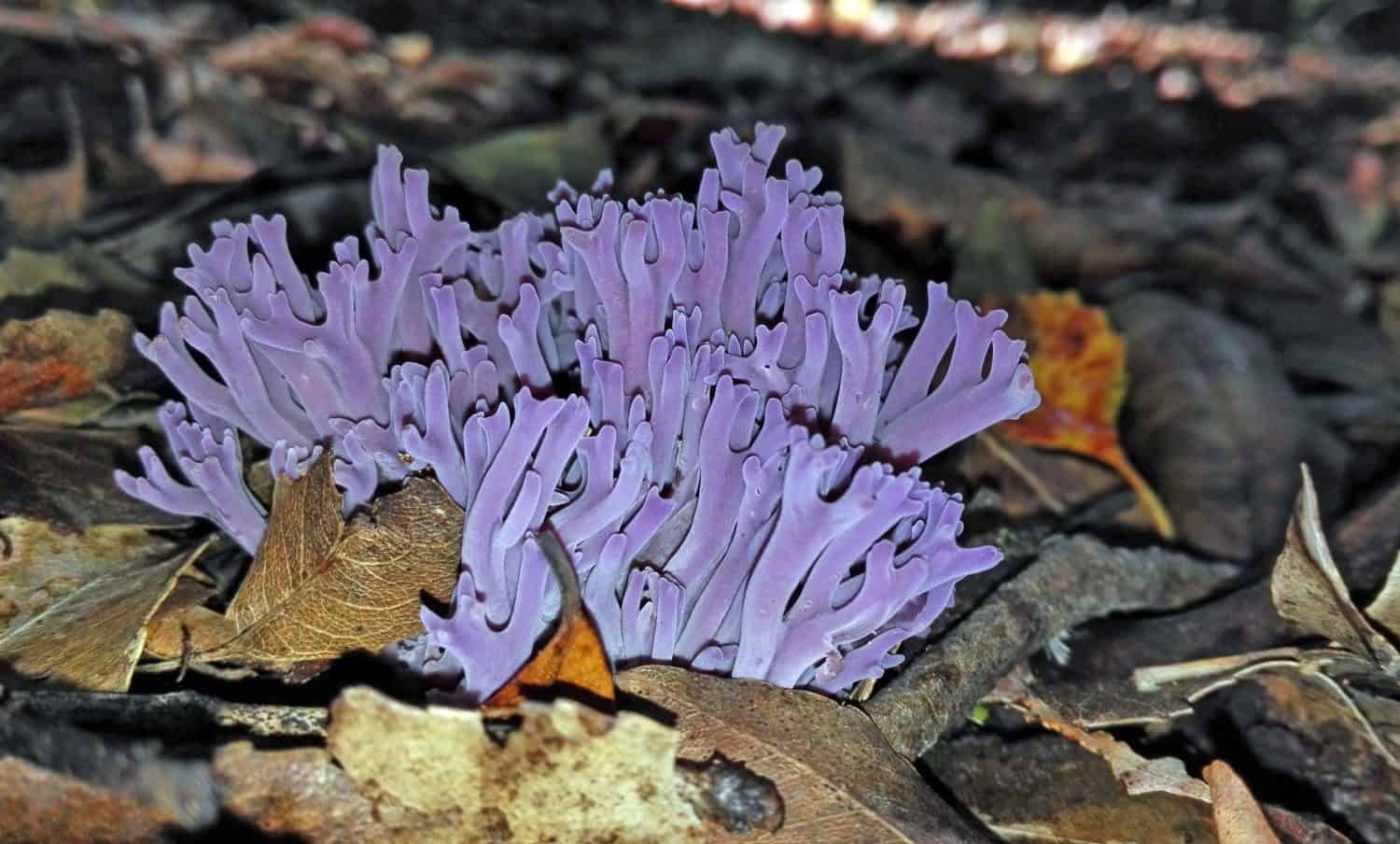
is one of the more vibrant and beautiful mushrooms,
©KarenHBlack/Shutterstock.com
Ivory Coral Mushroom (Ramariopsis kunzei)
When fresh, the ivory coral fungus (Ramariopsis kunzei, family Clavariaceae) features a lovely ivory-white coloration to its highly branching fruiting body. As it becomes aged, this mushroom typically turns off-white to cream-tan. The fruiting body can reach up to about 5 inches tall with branches that can measure 1-5 millimeters thick. The flesh is white and brittle. The spore print is also white.
Ramariopsis kunzei is widely distributed across temperate, forested regions of North America, Asia, Australia, and mainland Europe. This species is most likely saprobic and typically grows from the highly decayed matter along the forest floor or occasionally from thoroughly decayed bits of hardwood or conifers.

resembles a few other white coral mushrooms but has relatively distinct tips that come to a blunted point.
©samray/Shutterstock.com
Types of Coral Mushrooms: Yellow-Tipped Coral (Ramaria formosa)
The yellow-tipped coral (Ramaria formosa, family Gomphaceae) is particularly distinctive when young, at which time its hefty, stalk-like branches are a subtle cream-pink contrasting with the yellow tips. As it ages, the yellow-tipped coral mushroom becomes a bit more uniform in color, although the branch tips typically still retain a more notably yellow hue.
The flesh of Ramaria formosa is soft and off-white to cream-pink when young. The spore print is a yellow-orange. The fruiting body can reach up to 8 inches tall. This species is mycorrhizal, meaning the fungus derives its nutrients from a mutually beneficial relationship with the roots of plants. In the case of the yellow-tipped coral, the underground structure of the fungus (the mycelium) provides nutrients like phosphorus and nitrogen primarily to the roots of hardwood trees in exchange for sugars and carbon.
Ramaria formosa occurs in temperate, forested, primarily hardwood regions of Europe. It is most common in southern countries. It fruits from summer through fall. Some field guides will state that it is also found in North America, but this is most likely a very similar-looking but genetically distinct species.
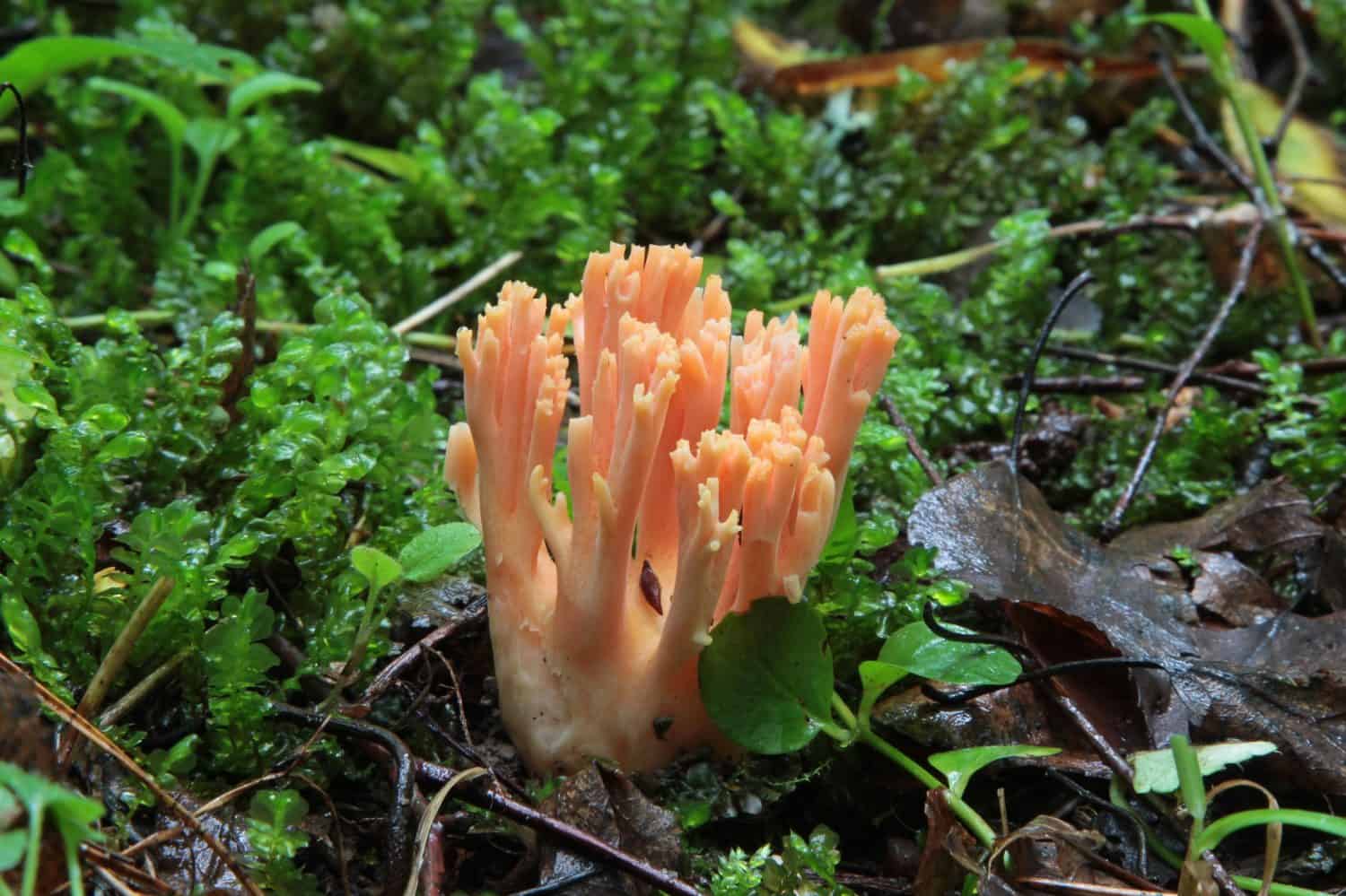
The pinkish salmon color is normally only visible on young specimens, as
Ramaria formosagets much more yellow with age.
©NK-55/Shutterstock.com
Types of Coral Mushrooms: Red Coral (Ramaria araiospora)
A strikingly colored coral fungus, the red coral mushroom (Ramaria araiospora, family Gomphaceae) features a smooth, highly-branched fruiting body in shades of pink to bright scarlet. When young, its fiery red fruiting body makes for a stunning find on a mushroom foray or forest walk. As it ages, Ramaria araiospora typically fades to a duller pink-orange or pale pink-red. Nonetheless, it is a beautiful fungus at all stages of its life cycle.
The smooth, vibrant fruiting body can grow up to 5 inches in height, with individual branches reaching 1-5 millimeters in thickness. The spore print is yellowish.
This species is likely mycorrhizal with hardwoods and conifers, particularly tanoaks and western hemlocks. In North America, the red coral fungus is most abundant along the coast of California, coastal western Mexico, and throughout the Pacific Northwest. Besides its North American home, Ramaria araiospora also occurs in lower elevations of the Himalayas, although future DNA sequencing may change our perspective on that.

is one of the brightest red-colored coral mushrooms in existence!
©Erin Springinotic / CC0 1.0 DEED CC0 1.0 Universal / https://www.inaturalist.org/photos/329593863 – Original / License
Crown-Tipped Coral Mushroom (Artomyces pyxidatus)
A uniquely-tipped species, the crown-tipped coral (Artomyces pyxidatus, family Auriscalpiaceae and actually in the same order as Russula!) is one of the easier coral mushrooms to identify once you look closely. The branch tips of this species feature a fairly squared-off depression surrounded by 3-6 distinctive points.
Artomyces pyxidatus grows in a dense cluster of off-white to yellowish crown-tipped branches. The fruiting body can grow up to 5 inches high and 4 inches wide. The crown-tipped coral is saprobic, commonly growing alone or scattered on the deadwood of aspens, tulips, willows, maples, and other hardwoods. Almost always growing on downed logs, its fruits spring through fall.
A widely distributed coral fungus, this species occurs throughout temperate, forested regions of the Northern Hemisphere. In North America, it is fairly widespread, albeit rare or potentially absent along the West Coast.
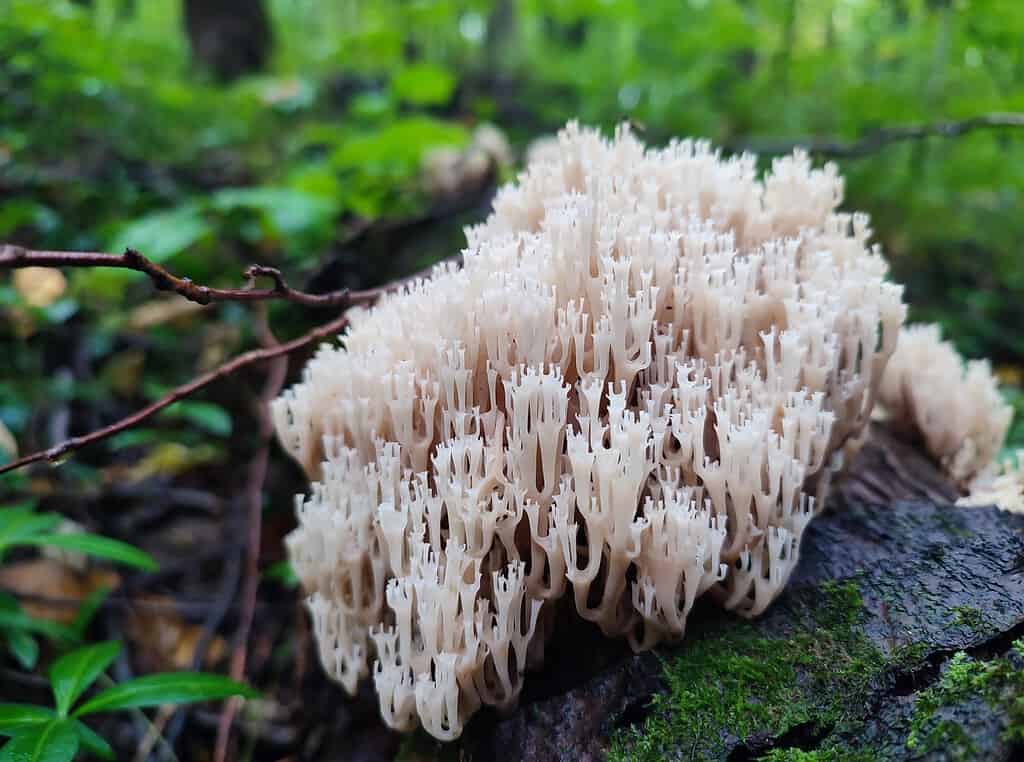
Looking like it’s straight from the ocean floor,
Artomyces pyxidatusis one of the more distinct and easier to identify edible coral mushrooms.
©Kristini/Shutterstock.com
Types of Coral Mushrooms: Green-Staining Coral (Phaeoclavulina abietina)
While unassuming at first glance, the green-staining coral (Phaeoclavulina abietina, family Gomphaceae, it used to be in the genus Ramaria) becomes quite distinguishable from lookalikes when cut or bruised. When the flesh is exposed to air, this appropriately named coral mushroom turns bruises bluish-green. With age, the branches also sometimes develop a greenish hue.
Non-bruised portions of the fruiting body are cream to yellowish. Its spore print is yellowish-brown. The branches are irregularly divided, and the branch tips are numerous, thin, and pointed. The fruiting body can reach up to about 3 inches tall.
Phaeoclavulina abietina occurs throughout temperate, conifer forest regions of the Northern Hemisphere. The green-staining coral mushroom in North America is most abundant in Monterey cypress and redwood forests along the West Coast.
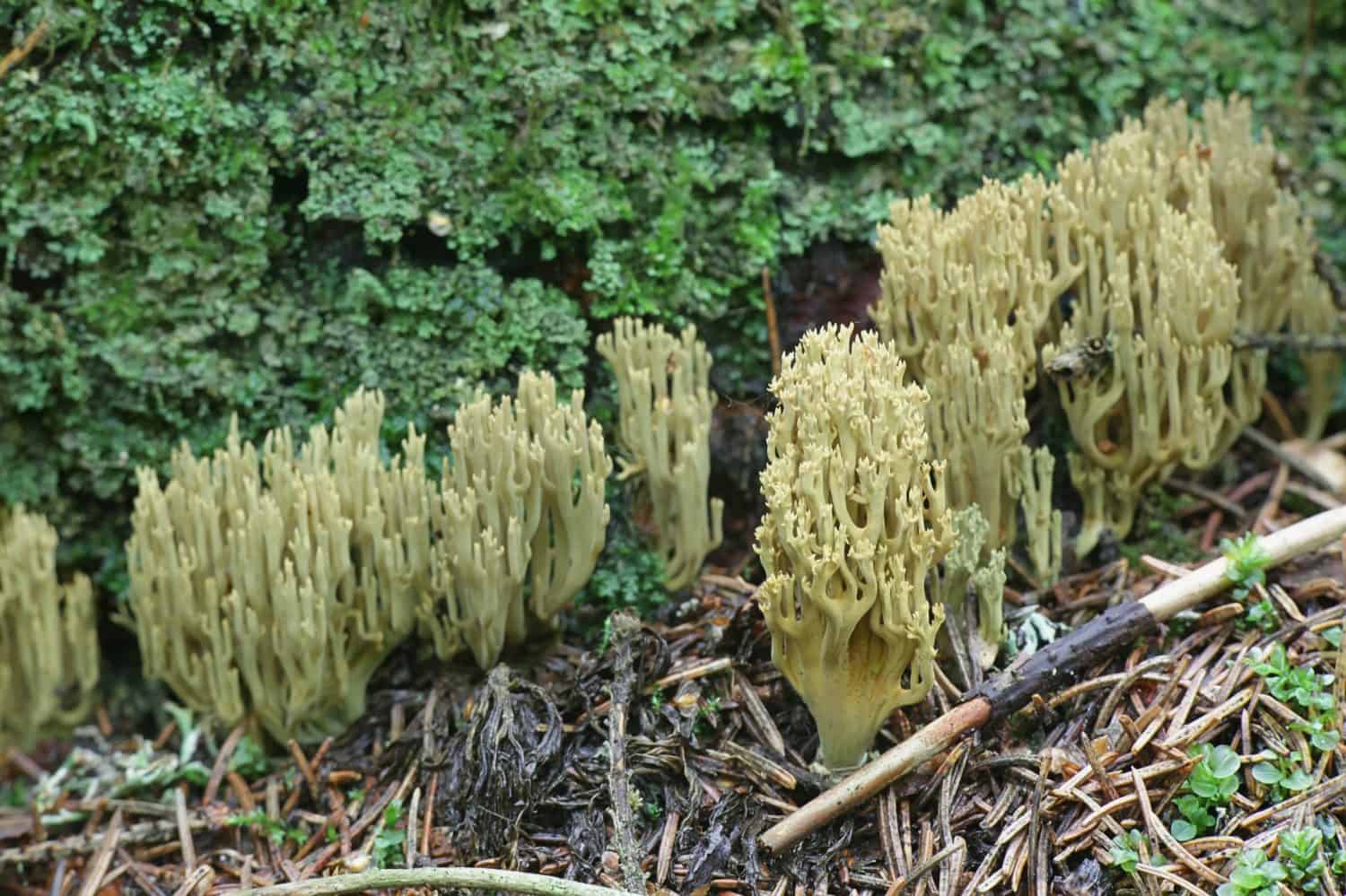
The blue-green staining makes
Phaeoclavulina abietinaone of the easier coral mushrooms to identify.
©Henri Koskinen/Shutterstock.com
Pink-Tipped Coral (Ramaria botrytis)
A dense, short-branched, and lovely species, the pink-tipped coral (Ramaria botrytis, family Gomphaceae) features cream-white basal branches that give way to beautifully rose-pink upper branches and tips. As the fungus ages, the branches become more elongated, and the base develops a yellowish or yellow-brown hue. The flesh is creamy white, and the spore print is yellowish. This species also looks a bit like a sponge.
This impressive coral fungus can grow up to 8 inches high and 12 inches across. Ramaria botrytis is mycorrhizal and typically found in mixed hardwood forests. It fruits from summer through fall in temperate regions and year-round in subtropical climates. This species is widely distributed across North America, North Africa, central and eastern Europe, Asia, and Australia.
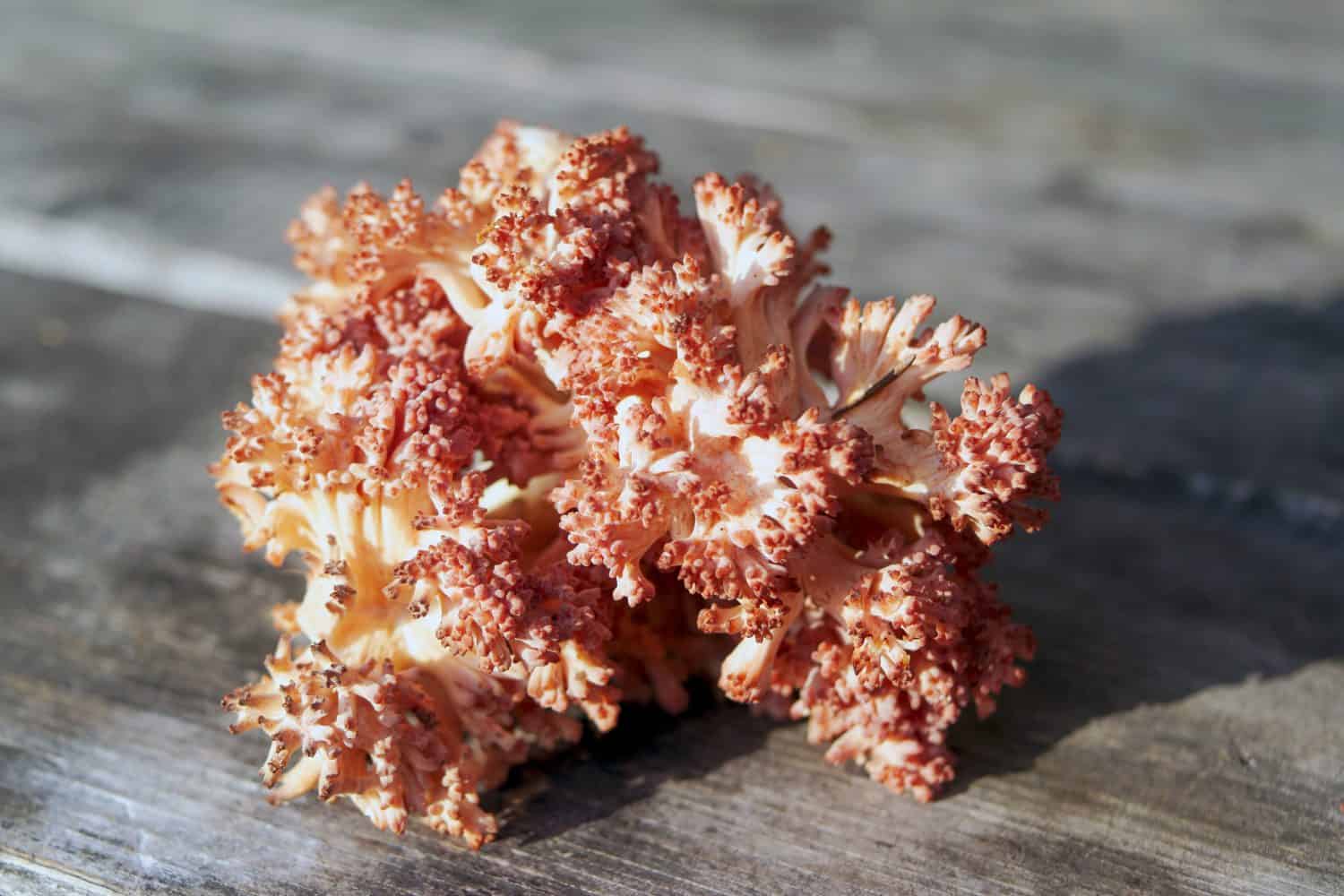
has beautiful purplish red colors towards the tips, especially when young.
©Anatoliy Berislavskiy/Shutterstock.com
Types of Coral Mushrooms: Lentaria micheneri
Lacking a common name, Lentaria micheneri, of the Lentariaceae family, is currently known only by its scientific name. One of the distinctive features of this beige coral mushroom is its prominent base and stalk. Especially in young specimens, the stalk can account for about half of the overall height before the fruiting body begins branching. The branches are densely formed and arranged vertically with slender, forked branch tips. The stalk is typically off-white, while the branches are beige to very pale orange. The flesh is quite tough. This small species only reaches a height of about 2 inches.
Mycologists have yet to pinpoint the ecological role of this Lentaria micheneri. It appears to have an affinity for growing under oaks, beeches, and pine trees. However, its mycelial growth pattern and spread may suggest a saprobic identification. It’s also possible this species could exhibit mycorrhizal and saprobic behaviors at different points along its life cycle.
Lentaria micheneri is widely distributed across forested regions of the Northern Hemisphere. In North America, it may only grow east of the Rocky Mountains.
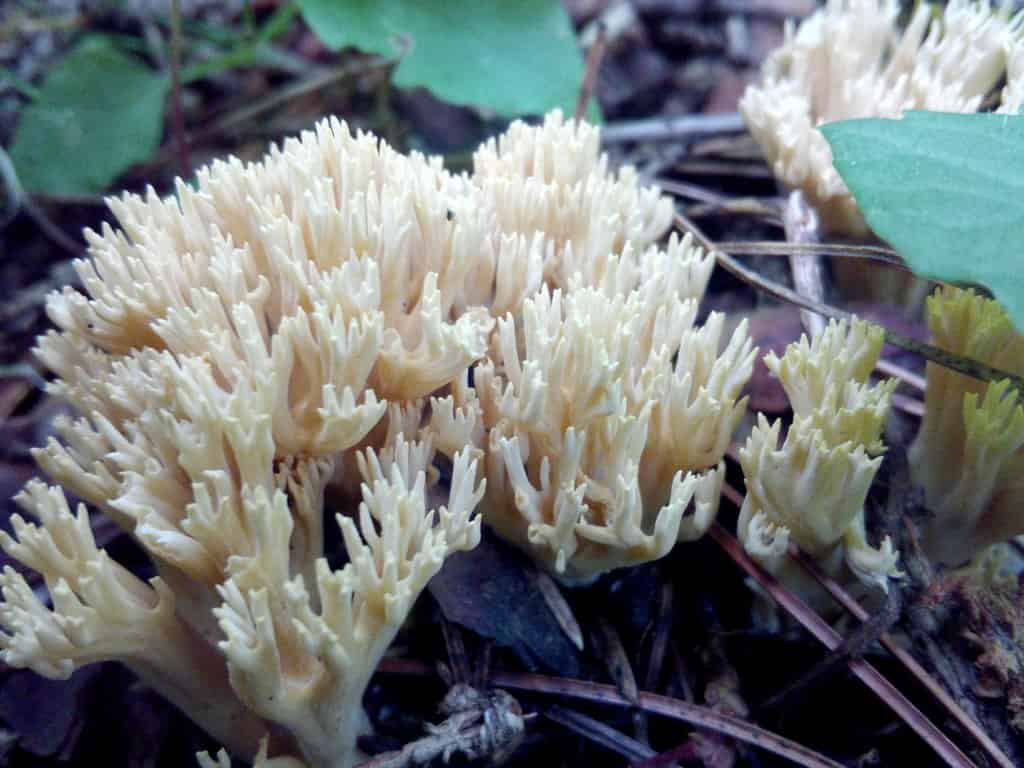
is a relatively rare mushroom.
©Виктория Билоус (viktoriabilous) / CC BY 4.0 DEED / https://www.inaturalist.org/photos/89744240 – Original / License
The photo featured at the top of this post is © KarenHBlack/Shutterstock.com
The information presented on or through the Website is made available solely for general informational purposes. We do not warrant the accuracy, completeness, or usefulness of this information. Any reliance you place on such information is strictly at your own risk. We disclaim all liability and responsibility arising from any reliance placed on such materials by you or any other visitor to the Website, or by anyone who may be informed of any of its contents. None of the statements or claims on the Website should be taken as medical advice, health advice, or as confirmation that a plant, fungus, or other item is safe for consumption or will provide any health benefits. Anyone considering the health benefits of particular plant, fungus, or other item should first consult with a doctor or other medical professional. The statements made within this Website have not been evaluated by the Food and Drug Administration. These statements are not intended to diagnose, treat, cure or prevent any disease.
Thank you for reading! Have some feedback for us? Contact the AZ Animals editorial team.







